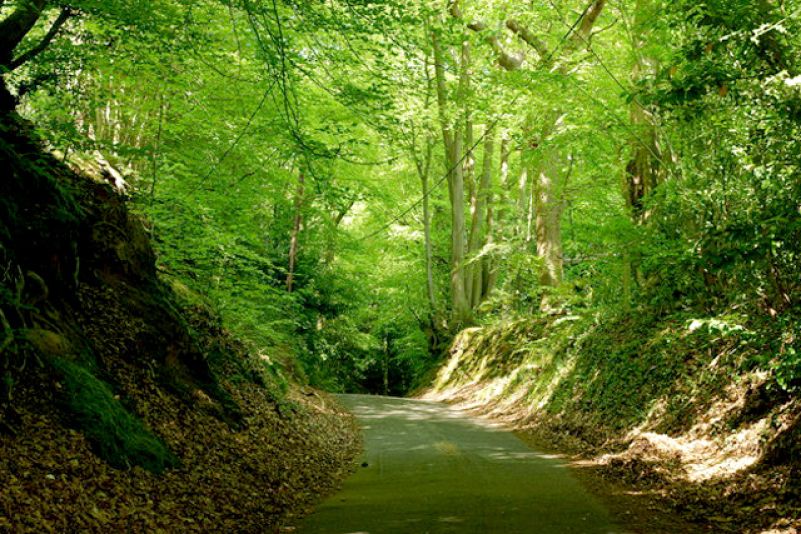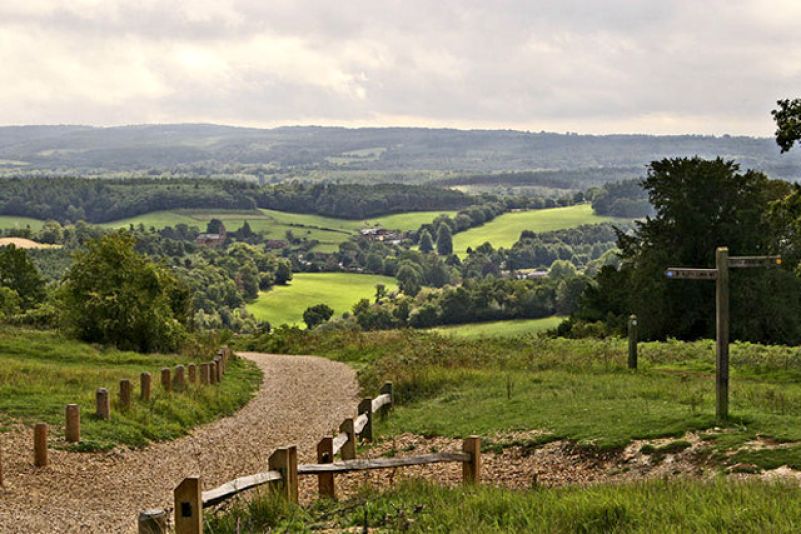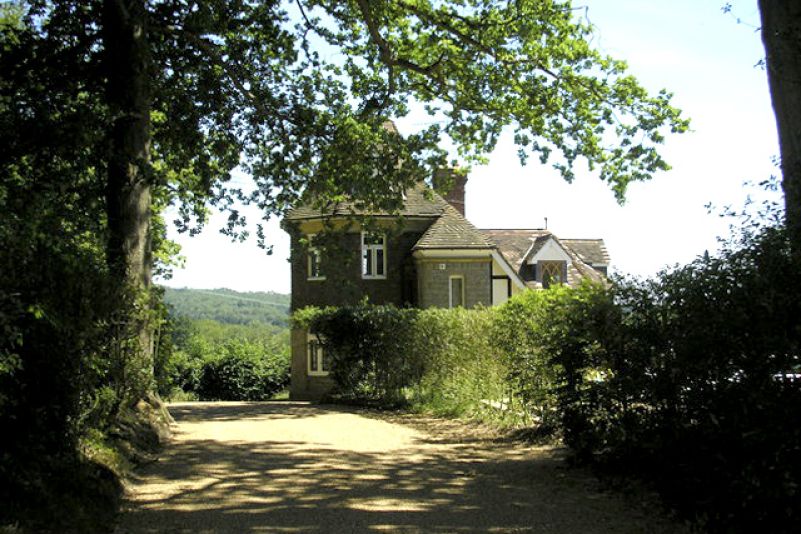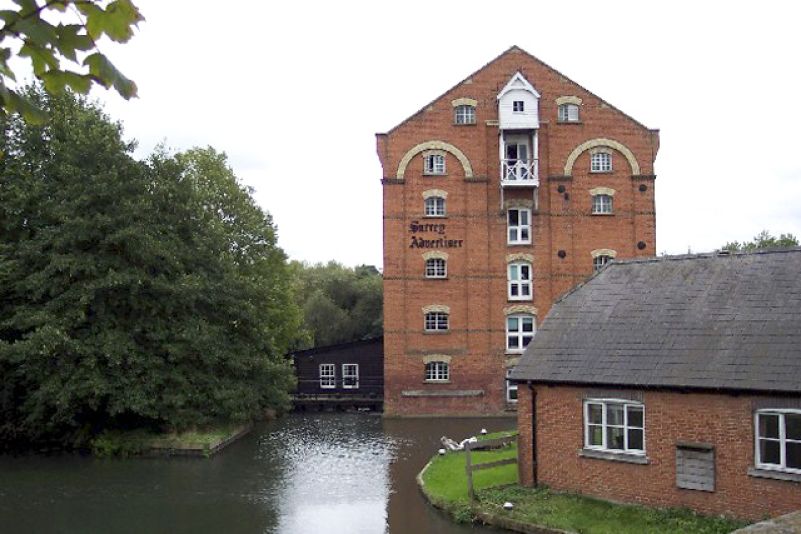Created Date:
Last Modified:
Autocarriers (1911) Ltd. and A.C Cars
The longtime location of one of Britain’s oldest motor companies.
Location
Ferry Works, Summer Road, Thames Ditton; High Street, Thames Ditton; and High House, Thames Ditton.
Date
1911 – 1986.
-
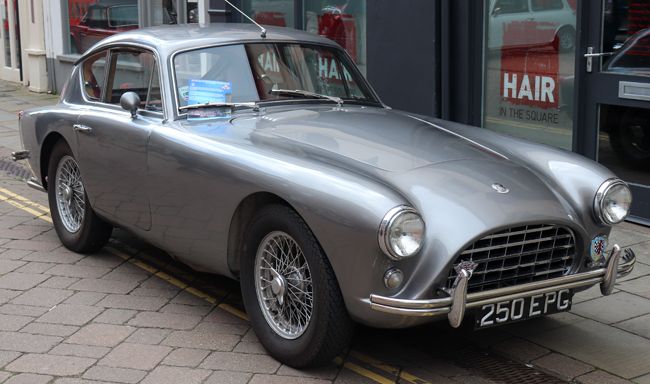 A Bristol-engined A.C Aceca, 1958; © Vauxford via Creative Commons Licence.
A Bristol-engined A.C Aceca, 1958; © Vauxford via Creative Commons Licence. -
 A.C’s well-established Tri-car, known as the ‘Sociable’ was the first car to be made at the Ferry Works, from a 1912 advertisement, source: Grace's Guide to British Industrial History
A.C’s well-established Tri-car, known as the ‘Sociable’ was the first car to be made at the Ferry Works, from a 1912 advertisement, source: Grace's Guide to British Industrial History -
 A 10 h.p A.C Light Car, 1913, fitted with a Fivet engine, and in 2016 was believed to be one of only three or four survivors, © Bonhams, New Bond St, London
A 10 h.p A.C Light Car, 1913, fitted with a Fivet engine, and in 2016 was believed to be one of only three or four survivors, © Bonhams, New Bond St, London -
 Shortly before the outbreak of war, the Light Car was also available as a van, source: Staffordshire Sentinel, 14th October 1914
Shortly before the outbreak of war, the Light Car was also available as a van, source: Staffordshire Sentinel, 14th October 1914 -
 Announcing the new six-cylinder car at the London Motor Show, The Light Car and Cyclecar, 19th November 1919, source: Grace's Guide to British Industrial History
Announcing the new six-cylinder car at the London Motor Show, The Light Car and Cyclecar, 19th November 1919, source: Grace's Guide to British Industrial History -
 The four-cylinder, single-seater A.C that travelled 101 miles in one hour at Brooklands in December 1922, source: The Sphere, 9th December 1922
The four-cylinder, single-seater A.C that travelled 101 miles in one hour at Brooklands in December 1922, source: The Sphere, 9th December 1922 -
 The Hon Victor Bruce (second from the right) with the A.C Six in which he won the 1926 Monte Carlo Rally, © National Motor Museum, Beaulieu
The Hon Victor Bruce (second from the right) with the A.C Six in which he won the 1926 Monte Carlo Rally, © National Motor Museum, Beaulieu -
 Kitty Brunell alongside the four-seater A.C Special Sports after winning the 10-16hp class in the 1933 RAC Rally, © National Motor Museum, Beaulieu
Kitty Brunell alongside the four-seater A.C Special Sports after winning the 10-16hp class in the 1933 RAC Rally, © National Motor Museum, Beaulieu -
 A two-door A.C Two-Litre Saloon, from the launch brochure, 1947, source: Tony Thorpe Collection
A two-door A.C Two-Litre Saloon, from the launch brochure, 1947, source: Tony Thorpe Collection -
 Cliff Davis driving his Tojeiro at the August Bank Holiday meeting at the Crystal Palace Circuit, source: The Sphere, 14th August 1954
Cliff Davis driving his Tojeiro at the August Bank Holiday meeting at the Crystal Palace Circuit, source: The Sphere, 14th August 1954 -
 A.C Ace, 1954, © Andrew Bone…, via Flickr
A.C Ace, 1954, © Andrew Bone…, via Flickr -
 A.C Greyhound, 1961, fitted with a 2216cc Bristol engine, © Andrew Bone…, via Flickr
A.C Greyhound, 1961, fitted with a 2216cc Bristol engine, © Andrew Bone…, via Flickr -
 The A.C Greyhound sales’ brochure showing the original frontal treatment, prior to the re-style that followed the car’s launch, source: Tony Thorpe Collection
The A.C Greyhound sales’ brochure showing the original frontal treatment, prior to the re-style that followed the car’s launch, source: Tony Thorpe Collection -
 A.C Cobra 289 Roadster, 1964, taken at the Chantilly Arts & Elegance Richard Mille 2015; © Eric Manesse via Creative Commons Licence
A.C Cobra 289 Roadster, 1964, taken at the Chantilly Arts & Elegance Richard Mille 2015; © Eric Manesse via Creative Commons Licence -
 A.C 428, 1968, © National Motor Museum, Beaulieu
A.C 428, 1968, © National Motor Museum, Beaulieu -
 A.C 3000ME, 1979, taken at the NEC Classic Motor Show, 2019; © Vauxford via Creative Commons Licence
A.C 3000ME, 1979, taken at the NEC Classic Motor Show, 2019; © Vauxford via Creative Commons Licence -
 The AC Ace, designed by Autokraft in consultation with Ford European Design Group; it was shown at the 1986 London Motor Show, but failed to reach production, source: Tony Thorpe Collection
The AC Ace, designed by Autokraft in consultation with Ford European Design Group; it was shown at the 1986 London Motor Show, but failed to reach production, source: Tony Thorpe Collection -
 The front cover of the sales brochure for the A.C Ace, made at Brooklands between 1994 and 1996 by Autokraft, source: Tony Thorpe Collection
The front cover of the sales brochure for the A.C Ace, made at Brooklands between 1994 and 1996 by Autokraft, source: Tony Thorpe Collection -
 An A.C Cobra Mk IV CRS (left), and an A.C 378GT Zagato, taken in 2012 at Brooklands, where the Cobra was built. Assembled in South Africa, the 378GT, fitted with a six-litre General Motors engine, is reportedly one of 15 cars produced, © Tony Thorpe
An A.C Cobra Mk IV CRS (left), and an A.C 378GT Zagato, taken in 2012 at Brooklands, where the Cobra was built. Assembled in South Africa, the 378GT, fitted with a six-litre General Motors engine, is reportedly one of 15 cars produced, © Tony Thorpe
Commentary
The roots of A.C (or Autocarriers Ltd, as it was originally known) go back to the turn of the century and to the south London suburb of West Norwood where John Weller and John Portwine established a thriving business manufacturing a small three-wheeled delivery vehicle, known as an Auto-Carrier. In 1907, a passenger version was launched, called a Tricar.
In October 1911, fast running out of space in their West Norwood workshops, Weller and Portwine moved the business out to a large factory at Thames Ditton.
Known as the Ferry Works, it had previously been occupied by Willans & Robinson, a firm of marine, and later electrical, engineers. Much of the building was destroyed by fire in 1886, and when it was rebuilt on more modern lines, the new factory is said to have been the first in the world to be entirely lit by electricity.
Coinciding with the move to Thames Ditton, the company was renamed Autocarriers (1911) Ltd, although by this stage, the name A.C was already being used on the cars.
The Auto-Carrier and Tricar continued to be manufactured at the new premises for a further three years, but in 1913, A.C developed its first four-wheel vehicle, the A.C Light Car.
Designed by John Weller, the car made extensive use of aluminium castings, keeping weight to a minimum. Finding a suitable engine, however, posed something of a problem. Eventually, the company settled on an 1100cc unit made by the French manufacturer, Fivet. Light, reliable, and relatively powerful for its size, the engine was installed in all the four-wheel A.Cs manufactured before 1914.
A second four-wheel car - a cyclecar with the Tricar engine and drivetrain – was also developed. However, although advertised, it does not appear to have reached full production.
With the onset of war in 1914, Autocarriers ceased car production, turning to the manufacture of munitions and engine parts. As a result, the Light Car did not go into full production until 1918, by which time further land had been bought by the company in the centre of Thames Ditton.
Unfortunately, the Fivet factory in northern France, close to the border with Belgium, had been badly damaged in the fighting, and although a number of castings, hidden during the War, were sent to Thames Ditton, A.C faced a long term problem of engine supply.
A solution was found with the British Anzani company in the form of a slightly larger (1500cc) 11.8 h.p four-cylinder engine, which, from 1925, A.C were able to make for themselves at Thames Ditton.
Although A.C had managed to find a suitable proprietary engine, it was John Weller’s long-held ambition for the company to make its own power unit. Working on its development in his spare time during the War, the project finally came to fruition in 1919. First announced in October of that year, just before the start of the Motor Show at Olympia, the two-litre, six-cylinder, overhead camshaft engine was immediately praised for its elegance and innovation.
In an article headed “Teeming with novelties” the Sheffield Daily Telegraph’s correspondent was one of many who praised the design for its “undoubted merits and originality”, pointing in particular to the engine’s lightness, again due to the extensive use of aluminium.
Ultimately, one of the most remarkable features of this engine was its longevity. It was used to power almost every A.C from 1922, when full-scale production began, to 1963, in the final A.C, Ace’s, Acecas and Greyhounds. With continuous development, power output rose from 40 to 105 bhp.
In February 1920, the (1911) was dropped from the company’s name, and in 1921, the businessman, racing cyclist and racing car driver, S.F Edge joined the board of directors. By April 1922, he was being referred to as the “Governing director”, and a few months later, both John Weller and John Portwine submitted their resignations, although John Weller is said to have retained his connection with the company as a consultant. In November 1922, the trading name was once again changed: from Autocarriers Ltd to A.C Cars Ltd.
The early to mid-1920s were, in many ways, a golden period for A.C. The defining feature of the company during this time was its huge sporting success, enthusiastically promoted by Selwyn Edge. According to A.C’s own official history, in 1921, the A.C Light Car broke 57 track records, and the company held more than 100 records at Brooklands – four times as many as any other car in the same class. In that year also, Harry Hawker, the Australian aviation pioneer, covered the flying quarter mile in a specially prepared A.C Light Car at a speed of 105.14 mph.
A year later, a single-seater A.C became the first light car (ie, one weighing less than ten hundredweight) to cover more than 100 miles in an hour, at an average speed of just over 101 mph.
By 1923, the six-cylinder A.C had also entered the record books, with fastest class times (more than 90 mph) for standing starts over 50 km and 50 miles. In May 1925, an A.C set a new 24-hour world record, irrespective of class, at the Montlhéry track, just outside Paris. Driving single-handedly, Thomas Gillett, A.C’s general manager at Thames Ditton, drove a total of 1,949 miles within a 24-hour period - a distance, as one newspaper pointed out, from England to Egypt.
The success of A.C cars was not confined to the race track. As well as excelling on economy runs (116 mpg was achieved in a specially prepared four-cylinder car), six virtually unmodified A.Cs (three Light cars and three two-litre models) climbed the 1 in 4 High Street at Clovelly in north Devon. In 1925, a six-cylinder A.C, driven by the Hon. Victor Bruce, with Thomas Gillett as passenger, was the first British car to compete in the Monte Carlo Rally and, a year later, A.C became the first British manufacturer to win the event; with a car again driven by Victor Bruce.
However, despite its many sporting achievements, A.C was unable to maintain sufficient sales. In 1927, Selwyn Edge bought the company, moving it in to private ownership – and, in the process, changing the name to AC (Acédès) Ltd. But the decline continued, and in 1929, the business went into voluntary liquidation.
Shortly after the closure, A.C was asked to provide (and, in fact, built) two six-cylinder engines to drive the electric dynamos on the R100 airship; a project overseen by Charles Dennistoun Burney, later responsible for the Burney Streamline.
In April 1930, A.C’s assets were bought by William and Charles Hurlock, whose family owned a haulage business that also sold and serviced lorries. Although the Ferry Works was not included in the purchase, the premises on High Street were retained, and these were used initially as a stores and servicing facility for existing A.C customers.
It appears that the Hurlocks did not initially intend to resume car manufacture, but the part-finished cars, and an extensive stock of components that came with the sale, seem to have persuaded the new owners to tentatively resume car production. By December 1930, A.C were once again advertising the sale of new cars – and it was not long before production was fully underway.
For the next five or six years the company offered a wide range of body styles all using the well-established six-cylinder engine in various states of tune. John Spencer, the A.C archivist, states that between 1932 and 1939, “at least 21 different models are recorded, ranging from conservative five-seater saloons to exciting competition two-seaters”. He adds that the model names ‘Ace’ and ’Greyhound’ were introduced during this period and the personal service offered by the company meant “there were probably never two cars quite alike”.
By the late 1930s A.C was involved, like many UK companies, in supporting the nation’s preparations for war. In 1938, they were producing aircraft parts, water trailers, and the bodywork for fire engines mounted on Ford and Bedford chassis. These orders put considerable pressure on the working space available at the Thames Ditton, and so further premises were acquired on Tagg’s Island on the River Thames, where A.C’s three-wheeler vehicles were later produced.
Car production at Thames Ditton resumed in 1947, with the announcement of the new A.C Two-Litre Saloon. The low, sleek, body was very different from previous models, but the six-cylinder engine, initially developed in 1919, was retained, albeit with a number of modifications. The water pump was moved to the side of the engine, improving circulation and allowing for a much lower bonnet line, and larger valves, together with new bearings, were also fitted. Capable of 80 mph, the car maintained A.C’s excellent reputation for roadholding and quality workmanship.
Made between 1947 and 1954 (although the last saloon was apparently not registered until 1958), 1,286 Two-Litre chassis were eventually produced. The vast majority were two-door saloons, together with 48 four-door cars, 90 Buckland and A.C Sports Tourers, and a small number of estate and special-bodied cars.
By 1953, sales of the Two-Litre were becoming relatively slow, and A.C were looking for a replacement. They found it, thanks to Ernie Bailey, farmer and owner of the Buckland Body Works, based at Buntingford in Hertfordshire, who built the Buckland Sports Tourer, the convertible version of the A.C Two-Litre.
Amongst his small workforce at Buntingford was John Tojeiro, a self-taught engineer, who had developed a relatively simple H-frame ladder chassis on which a number of ‘Specials’ were built and raced, with some success.
In 1953, Tojeiro was commissioned by Cliff Davis, a successful sports car driver, to build a chassis for a Bristol-engined convertible on which was fitted a body closely resembling that of the Ferrari 166 MM Barchetta. Originally fitted to a Cooper-MG, it was built by Gray and Rich Panelcraft of Hammersmith.
When Ernie Bailey heard that A.C were looking for a new model to replace the Two-Litre, he introduced John Tojeiro to Charles Hurlock. The A.C deputy managing director was evidently very impressed with the design, and offered to put the car in production, reportedly agreeing to pay John Tojeiro a royalty of five pounds per car, limited to 100 cars.
The A.C Ace, as it became known, first appeared at the 1953 Earls Court Motor Show – initially using the original Gray and Rich body. Prior to production, A.C’s chief engineer, Alan Turner, made a number of small changes to the front and rear of the car which made a significant difference to the car’s overall appearance, producing arguably one of the most graceful cars of its era.
Although initially fitted with A.C’s longstanding six-cylinder, two-litre engine, with output raised to 85 bhp, the Ace was nevertheless a modern design, with all-round independent suspension (the first British post-War sports car to do so), and a top speed of just over 100 mph.
Towards the end of 1954, the Aceca was introduced – essentially a coupé version of the Ace, with a light alloy body.
By 1955, the new Ace was beginning to chalk up some sporting success, particularly in the hands of Ken Rudd, an engineer and racing driver, based in Worthing, who had bought an Ace at the 1953 Motor Show. He later became the West Sussex dealer for A.C Cars.
In the search for greater power, Ken Rudd re-fitted the Ace with a two-litre Bristol engine and, from early 1956, this became a factory-fitted option for both the Ace and Aceca.
Following the demise of the Two-Litre saloon, A.C introduced a new four-seater model, the Greyhound; first shown to the public at the 1959 Earl’s Court Motor Show. Once again designed by Alan Turner, and using an extended Ace/Aceca chassis, the Greyhound was 10in longer and 4in wider than the Aceca. On its initial appearance, the car received a number of negative reviews and, in the light of this, the chassis was strengthened, and the front grill, nose and rear window re-styled. Only 82 cars were finally sold, almost all with a Bristol engine; just six were fitted with the latest version of John Weller’s original light-six.
With Bristol deciding in 1961 to cease production of their two-litre engine, A.C needed to find an alternative power unit. Thanks again to the development work of Ken Rudd, a solution was found in the form of the 2.6-litre Ford Zephyr engine. Lighter, and cheaper to produce than both the A.C and Bristol engines, the Ford power unit, with triple S.U carburettors, produced 125 bhp in its standard form, and was fitted to both the Ace and the Aceca.
In 1959, a Bristol-engined Ace, entered by Ken Rudd, finished seventh at Le Mans. The race was won by Roy Salvadori and Carroll Shelby, driving an Aston Martin DBR1, and it was Carroll Shelby, who three years later, ushered in the next phase of A.C history.
Born in Texas in 1923, Shelby had raced with considerable success during the 1950s. After retiring from motor sport in 1960 with a heart problem, he set about developing his idea of an Anglo-American sports car; notably one with a large American V8 engine fitted to a lightweight British chassis. After being rejected by Austin-Healey, his first choice, and also by Chevrolet, he had more success with A.C and Ford.
The thin-wall Ford V8 was smaller and lighter than the Zephyr 6, and fitted relatively easily into the Ace’s engine bay; however, the new car’s increased torque and much higher top speed, meant that A.C needed to make a number of changes to the chassis, drivetrain, and bodywork. Despite this, the car was developed remarkably quickly, and by early 1962, Cobra production was underway at Thames Ditton.
Between February 1962 and November 1964, almost 600 Cobras were built by A.C under contract to Carroll Shelby, with engines and gearboxes fitted in the States. The first 75 cars had 4.2-litre engines, with most of the remainder having the larger 4.7-litre power unit. There were also a few 7-litre cars.
62 cars were entirely assembled by A.C. These, unlike those exported to America, were right-hand drive and marketed as the A.C Cobra.
From 1965 to 1966, a further 315 cars were built at the A.C factory for export to America, where the seven-litre engine was generally installed. These models were known as the Shelby Cobra 427, so-called because of the size of their engine: seven-litres or 427 cu in.
The last Cobras made at Thames Ditton, numbering 27 in all, had 4.7-litre engines; these were called the AC 289 Sports.
Although the Cobra soon developed a reputation for raw speed and sporting success (later becoming the basis of numerous replicas), it was a relatively unsophisticated car and not without its flaws. Perhaps it was this that led to A.C developing its next model, the 428: a high-speed luxury tourer.
Based on a design developed by the Italian stylist and coachbuilder, Pietro Frua, the 428 used an extended Cobra chassis, with a Ford 7014cc V8, linked to a three-speed automatic gearbox. Available as a convertible or fastback coupé, the cars began life in Thames Ditton as a rolling chassis from where they were dispatched to Turin to be fitted with a body, and then returned to England for completion.
Although the car was fast, it was not perfect. It was also considerably more expensive than much of its competition. Industrial unrest in Italy created problems with supply and delivery, and rising oil prices were, for a car that could only manage around 16 mpg, probably the final nail in its coffin. In all, 80 cars were built, between 1965 and 1973.
In January 1973, a new glassfibre-bodied, mid-engined sports car caused considerable interest at the Olympia International Racing Car Show. Named ‘Diablo’, it was designed by motorsport engineers Peter Bohanna and Robin Stables, and built around a spaceframe chassis, powered by an Austin Maxi 1485cc engine.
Soon afterwards, the car was taken to the A.C factory and shown to Derek Hurlock, William Hurlock’s son, as a potential replacement for the 428. The A.C Chairman, reportedly, had some doubts about the amount of work that would be required to put the car into production, but was swayed to give his approval by enthusiasm of his colleagues.
The first difficulty was finding a suitable engine for the car after BLMC had told A.C that they would unable to provide the Maxi unit for production. Ford, however, were more helpful, and agreed to supply their three-litre V6 unit, already installed in the Capri and Granada.
Other changes to the original design included replacing the spaceframe chassis with a steel tub and a front and rear subframe, building a new gearbox casing, and designing a more luxurious interior. Detailed alterations were also made to the design of the bodyshell.
Re-named the A.C 3-litre Sports, the revised prototype was shown to the public for the first time later in the year at the Earls Court London International Motor Show. The car attracted great interest; about 300 orders are said to have been taken, with a view to production beginning the following year.
However, the imposition of new safety regulations following Britain’s entry to the EEC in 1973 caused major problems for A.C’s engineers, especially when the new car narrowly failed the 30 mph crash test.
Inevitably, each of the changes required pushed the launch date further and further back. Just to make things worse, the increased development costs were compounded by the high level of inflation that was affecting the British economy as a whole. For the next five years, motor shows came and went, with A.C promising each time that the launch of the new car, now re-name the A.C 3000ME, was imminent.
With development costs estimated to be in the region of £1 million, the new car at last went on sale towards the end of 1978. It was again generally well-reviewed (although there were some criticisms of its roadholding), but the long delay in starting production gave rise to the car’s major drawback – its price. When the A.C 3-litre was first shown at Earls Court in November 1973, the projected sale price was estimated at £3,000-£4,000. By 1978/9, this had risen to £12,342 – over a thousand pounds more expensive than a Lotus Eclat.
With slow sales, A.C closed its dealerships in 1981, by which time its output from Thames Ditton was reportedly based primarily on the construction of railway carriages and other government equipment (Car, August 1981). 3000ME production over the car’s five-year life with A.C was just 76 vehicles.
In 1984, A.C closed its doors in Thames Ditton for the final time. In 2021, the Ferry Works was still standing, as was part of the 1925 sales office in High St. The main works in High St were demolished around 1987 and replaced with modern office facilities, known as 'AC Court'. The Summer Road works - by the railway crossing about a mile from the village centre – have also survived.
However, this was not quite the end of the ME3000, or even A.C itself. Manufacturing and marketing rights of the sports car were sold to a new company, A.C (Scotland), based at Hillington, on the western outskirts of Glasgow, where a further 30 cars were made until that too collapsed in 1985.
In 1987, CP Autokraft and the Ford Motor Company obtained joint-ownership of A.C. The former had repaired and re-built Cobras since the 1970s and the owner, Brian Angliss, had been granted a licence to use the A.C name in 1981. Ford, of course, had been supplying A.C with a range of engines since the early 1960s.
The consortium operated out of Autokraft’s factory at Brooklands, producing the A.C Cobra Mk IV to the highest level of quality. However, in 1990, Ford attempted to wind up the partnership, but eventually agreed in 1992 to sell their 50.96% share In A.C to Autokraft.
Before acquiring A.C, Ford and Autokraft had announced, in 1986, a new four-wheel-drive 2+2 sports car; once again slightly confusingly known as the A.C – Ace. Designed to be powered by either Ford’s 2.8-litre V6 engine or the Sierra RS Cosworth’s turbocharged 2.0-litre unit, the project failed to proceed beyond the concept stage. Today the car is often called the Ace of Spades.
Despite this setback, Brian Angliss persisted with his idea for a new sports car. Development however was, once again, rather slow and expensive, but at the end of 1993, the new car, styled by IAD of Worthing, was shown to the public, with deliveries beginning, in June 1994. Known today as the A.C Ace Brooklands, it was fitted with Ford’s 4.9-litre V8 Mustang engine, with a hand-built aluminium body. The car was expensive to produce, and almost certainly sold at a loss.
By 1996, 46 cars had been built (four were sold to the Sultan of Brunei), but once again, A.C Cars, together with Autokraft went into receivership.
The assets were bought by South-African born entrepreneur Alan Lubinsky who, in 2021, remains the owner of AC Cars (England). The Ace Brooklands continued to be produced in small numbers until 1998, by which time some of the aluminium body panels had been replaced by fibreglass, as a cheaper alternative.
In 2021, AC Cars, with their registered office at the Hethel Engineering Centre, Chapman Way, Hethel, were offering two distinct versions of the Cobra: one using a conventional 6.2-litre V8 engine (this time sourced from General Motors), and the other with a choice of electric motors of varying power.
With thanks to A.C archivist, John Spencer, on whose work this article has drawn.
Other locations
• West Norwood, London
• Tagg’s Island, Middlesex
Further details
• AC, Martin Watkins, Haynes Foulis, 1976.
• The History of A.C Cars Ltd, R.G. Henderson, Fullerton & Lloyd, 1952.
• AC Two-litre Saloons & Buckland Sports Car, Leo Archibald, Veloce Publishing Ltd, 2002.
• Surrey and the Motor, Gordon Knowles, Surrey Industrial History Group, 2005.
• The AC Owners’ Club: https://www.acownersclub.co.uk/.
• The AC 2ltr Saloon and derivatives produced between 1947 & 1958: www.ac2litre.com.
• The AC 3000ME: www.ac3000me.com.
• AC Cars, the official website: https://www.accars.eu/.
